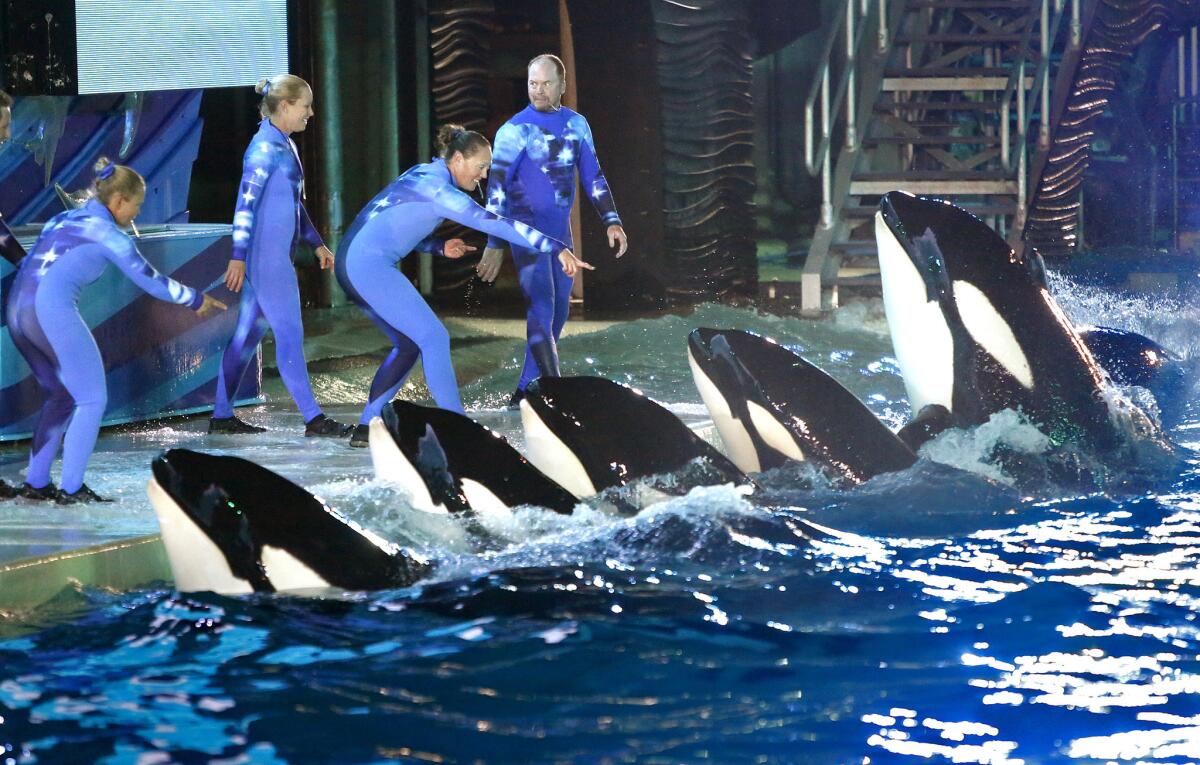Orca dispute between SeaWorld, Coastal Commission could go to court

Trainers direct orcas at SeaWorld San Diego in 2014. The Coastal Commission wants to stop the captive breeding of orcas.
- Share via
The public and media seemed surprised last week when the California Coastal Commission ordered SeaWorld San Diego to halt captive breeding of orcas as a condition of getting a permit to build a larger exhibit space for the 11 marine mammals.
But the commission’s decision to take the unprecedented step came after weeks of behind-the-scenes wrangling between Coastal Commission staff and SeaWorld attorneys over whether, in effect, the 1966 federal Animal Welfare Act gives the commission authority over the care and management of captive orcas, also known as killer whales.
If, as the San Diego Union-Tribune newspaper is urging, SeaWorld takes the Coastal Commission to court seeking to overturn the anti-breeding condition, the dispute over that 1966 law, and other legal arcana about the relative authority of state vs. federal agencies over marine mammals, will be central.
See the most-read stories this hour >>
SeaWorld officials have not said whether they plan litigation, just that all options are being considered.
Meanwhile, the commission’s ruling has been applauded by People for the Ethical Treatment of Animals and other activist groups. Among those urging the commission to stop SeaWorld from allowing its orcas to reproduce was Sara Wan, former Coastal Commission chair and now with the Animal Legal Defense Fund.
Documents posted on the Coastal Commission website reveal the effort of SeaWorld attorneys to convince commission staff to warn commissioners that there is no legal basis in federal law or the Coastal Commission Act for the commission to seek to determine how captive orcas are treated.
Despite letters on April 13, Aug. 21, and Oct. 1, SeaWorld’s main attorney, David Watson, from the Duane Morris law firm, was not able to convince commission staffers that “federal law pre-empts all state laws involving any aspect of public display, exhibition, conservation and management of marine mammals.”
If the federal government were to allow the state to control marine mammals, it would likely authorize an agency like the Department of Fish and Wildlife, which has expertise about animals, not the Coastal Commission, Watson argued.
The commission staff report, approved by Alexander Lierandi, coastal program analyst, disagrees with Watson. Rules about taking mammals from the wild, the report said, are clearly a federal responsibility, but once the mammals are captive, they also fall under the Animal Welfare Act, the report asserts.
Just because the Department of Fish and Wildlife has not established rules about the care and management of orcas, that does not preclude the Coastal Commission from establishing such rules, including limits on breeding, according to the staff report, which was accepted enthusiastically by commissioners at last week’s meeting.
Orcas are on display at four parks in the U.S.: 11 at SeaWorld San Diego, seven at SeaWorld San Antonio, six at SeaWorld Orlando in Florida, and one at Miami Seaquarium. State officials in Texas and Florida have not sought to regulate the care and management of orcas at those facilities.
SeaWorld San Diego had agreed not to seek to capture any more orcas in the wild. It has not done so in more than three decades. But it drew the line at agreeing to stop the breeding effort; eight of its 11 orcas were born in captivity.
As SeaWorld San Diego loyalists note, the Coastal Commission logic would suggest that the commission has authority over all the marine mammals at the park, and not just when the park is requesting a building permit.
If SeaWorld San Diego is blocked from allowing the orcas to breed, and also blocked from bringing orcas in from other SeaWorld parks, the lifespan of the orca shows, long the most popular feature at the park, would seem limited.
Still, the ages of the San Diego orcas – two are 2 years old, three are in their early teens, three are in their 20s – suggests that the show at Shamu Stadium could continue for several decades with or without the enlarged tanks that the park wants to build.
PETA has long asserted that the orcas are suffering in tanks that are too small and have been turned into circus performers. In 2012, PETA asked a federal judge in San Diego to rule that the orcas deserved protection under the 13th Amendment to the U.S. Constitution that banned slavery; the judge ruled that the amendment does not cover animals.
After the commission’s decision at its Long Beach meeting, PETA official Jared Goodman said that the move “ensures that no more orcas will be condemned to a nonlife of loneliness, deprivation and misery.”
On Friday, SeaWorld posted messages on social media, including testimony from its officials to the commission. SeaWorld also posted an editorial in the Union-Tribune newspaper branding the commission action “authoritarian” and calling for SeaWorld to take the issue to court.
In the past, SeaWorld has enjoyed nearly unanimous support from local elected officials, noting its prominence as a tourist attraction, large employment base and the rent it pays to the city for the site on Mission Bay. In the wake of Thurday’s decision, those same officials remained mum, declining requests by The Times for their comments.
One official who did comment was San Diego Councilwoman Lori Zapf, who said she hopes SeaWorld goes to court.
“What’s at stake here is the future of SeaWorld,” she said. “San Diego without SeaWorld is unimaginable.”
Twitter: @LATsandiego
More to Read
Sign up for Essential California
The most important California stories and recommendations in your inbox every morning.
You may occasionally receive promotional content from the Los Angeles Times.













